Lille are well known for consistently producing young players who go on to make a significant impact on the global stage. The academy’s commitment to nurturing young talents has fortified the club’s position in the footballing hierarchy and contributed to the broader narrative of player development in France.
One standout alumnus of the LOSC academy is, of course, Eden Hazard, a name that resonates within the confines of Lille and across the footballing world. The Belgian maestro, known for his dazzling dribbles and creative flair, honed his skills in the academy before making a seamless transition to the first team. Hazard’s footballing journey saw him light up the Premier League with his performances at Chelsea before moving on to Real Madrid.
Current manager Paulo Fonseca is committed to giving opportunities to young players. 18-year-old centre-back Leny Yoro has graduated from the academy system and cemented his place in the Lille first team. He is excelling with his performances in Ligue 1. Additionally, former Manchester United academy player Angel Gomes continues to thrive since making the move to northern France.
In this tactical analysis and scout report, we will highlight three players we believe can follow in the footsteps of Hazard and Yoro by making the step up into the Lille first team. We will analyse how they fit into the youth team tactics and what their individual skill sets can bring to Fonseca’s side.
Aaron Malouda
The first player we are going to look at in this analysis is Aaron Malouda. As many will know, he is the son of former footballer Florent Malouda. Malouda Sr, of course, was a mainstay in Lyon’s dominant side of the early-mid 2000s and won four of their seven in a row during his time at the club. He then went on to win the Champions League with Chelsea and make 80 appearances for Les Bleus. Aaron certainly has some big shoes to fill.
Aaron Malouda is a new signing at Lille, having signed from Rennes II in July 2023, so for this section, we will use footage from both clubs to give a good overview of his style of play.
The best way to describe Aaron Malouda as a footballer is dynamic and direct. He can play as an inverted winger on the left, cutting in on his favoured right foot or as an out-and-out winger on the right. Malouda is also comfortable playing as a central attacking midfielder, which means he is very versatile and can bring a lot of quality in the attacking phase.
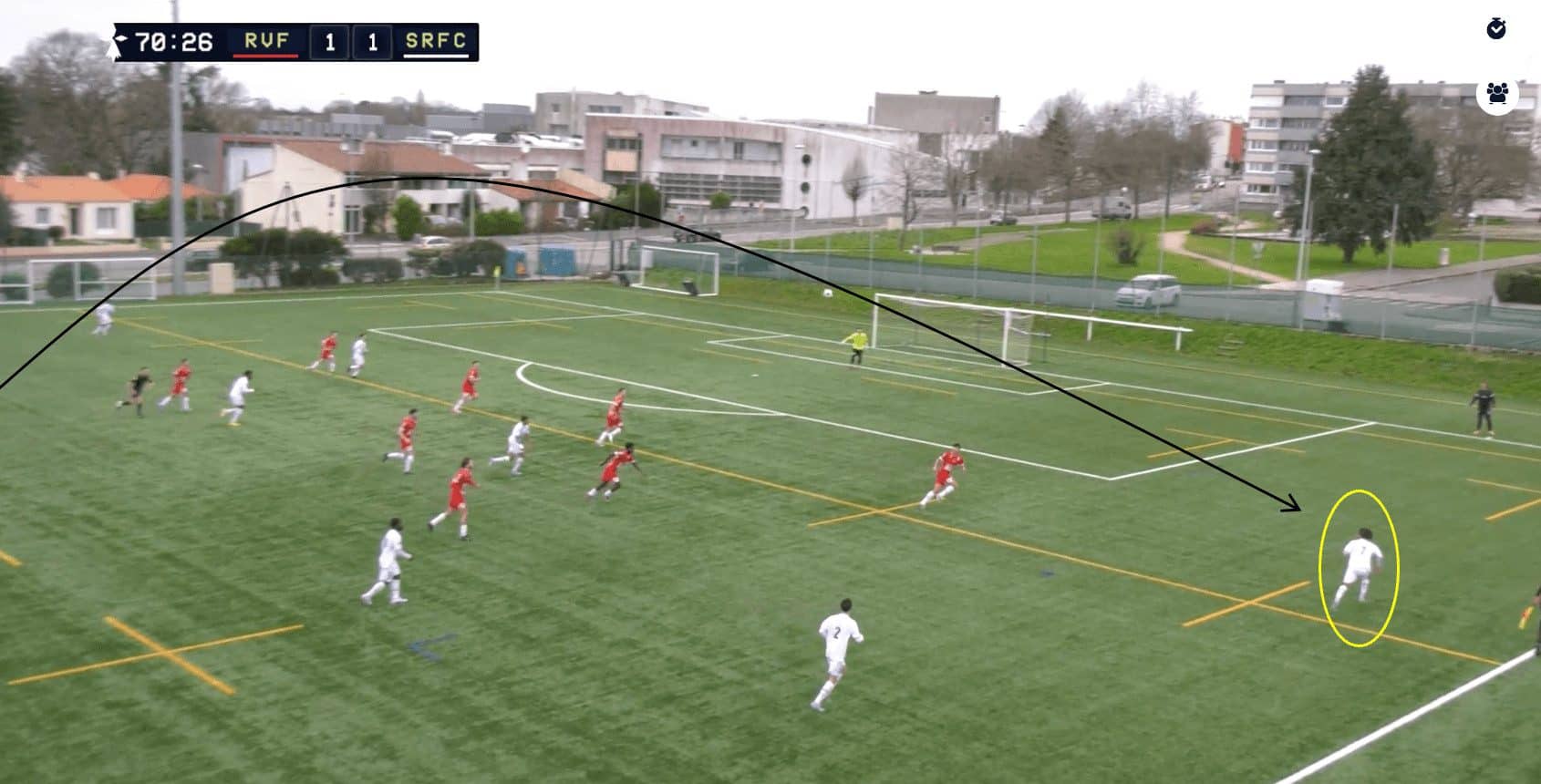
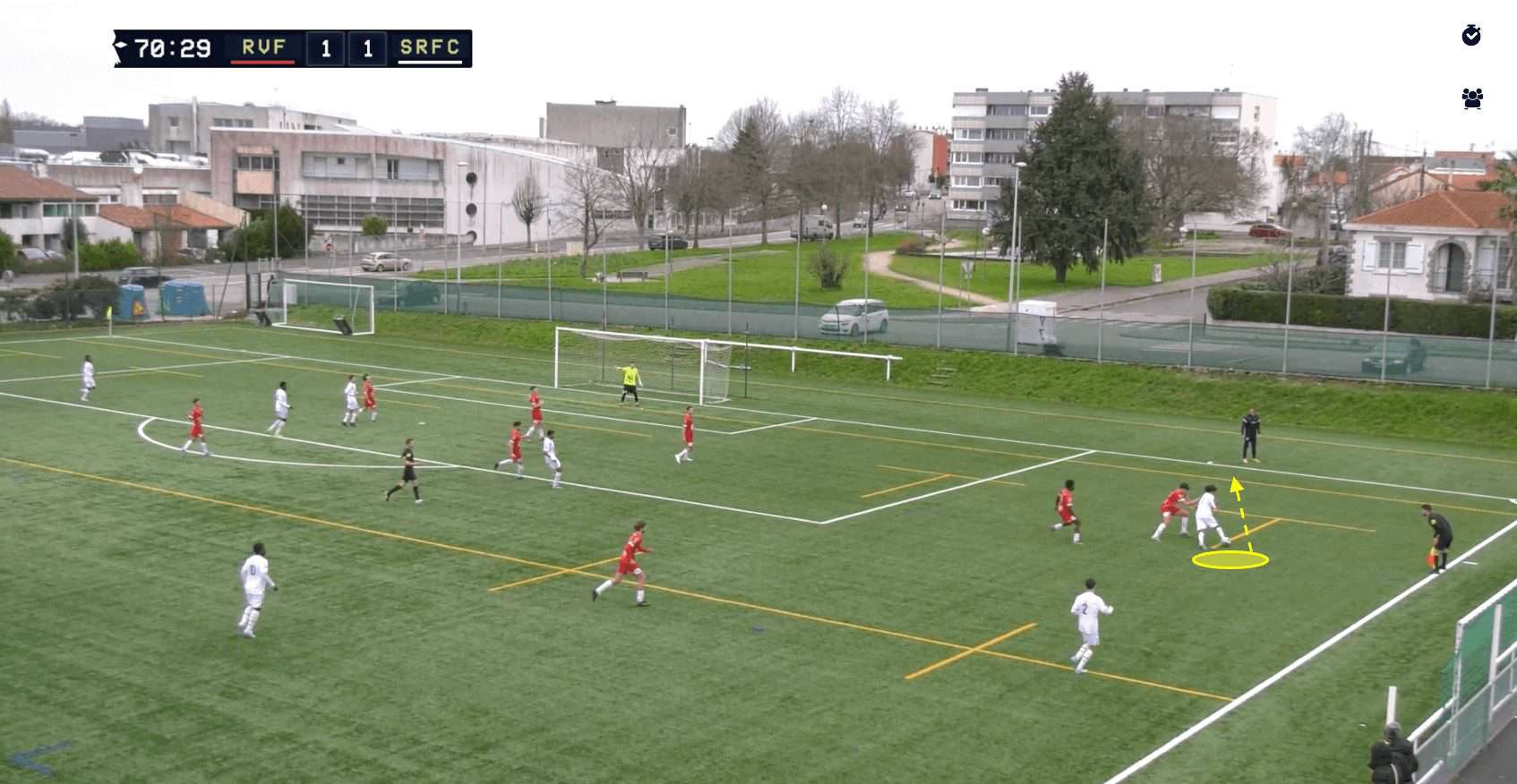
First and foremost, Malouda is a skilful player who loves to take on opponents one-on-one; as a result, he creates numerous goalscoring opportunities for his team. We can see in this example from his time at Rennes, when the ball is played out to him, and he utilises his dribbling ability and strength to take on the opponent. Malouda can bypass defenders with his nimble footwork and quick speed changes when carrying the ball forward. This puts additional pressure on the opposition’s backline and opens up spaces for other attacking players to exploit. As we can see, two opposition players are drawn out to try to stop him.
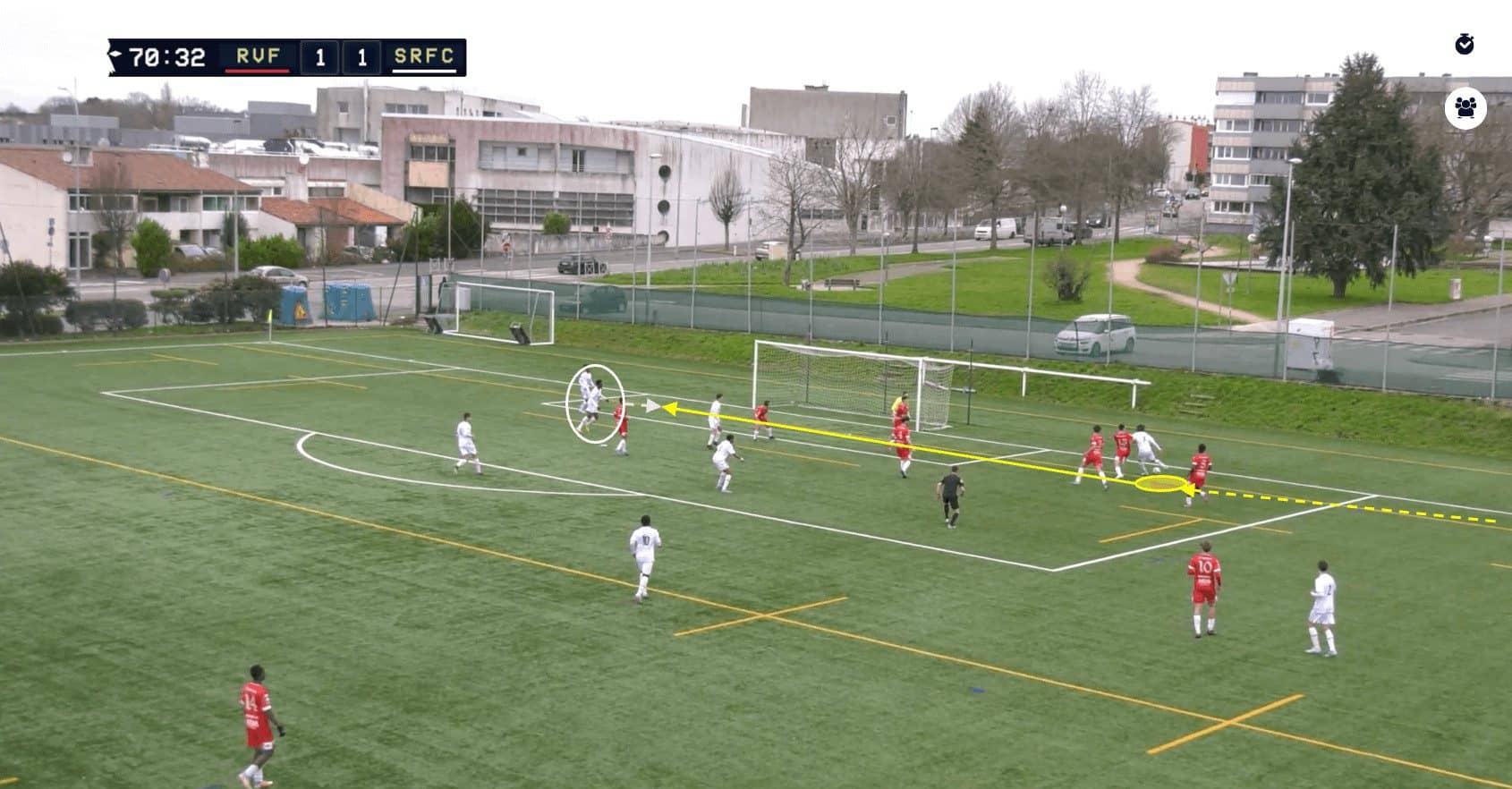
Despite the defender’s best efforts, Malouda can cut into the penalty area and play a driven cross into the six-yard box, which is turned goalwards by a teammate. Malouda’s direct style of play adds pace and urgency to the team’s offensive transitions. He averages 7.2 take-ons per 90, showing how much he likes to bypass his opponent.
The 18-year-old stretches the opposing defence by swiftly advancing down the flank, creating gaps and openings in central areas due to defenders being drawn out to stop him. This forces the defenders to make quick decisions and adjustments, often leaving them vulnerable to overlapping runs or crosses being played in.
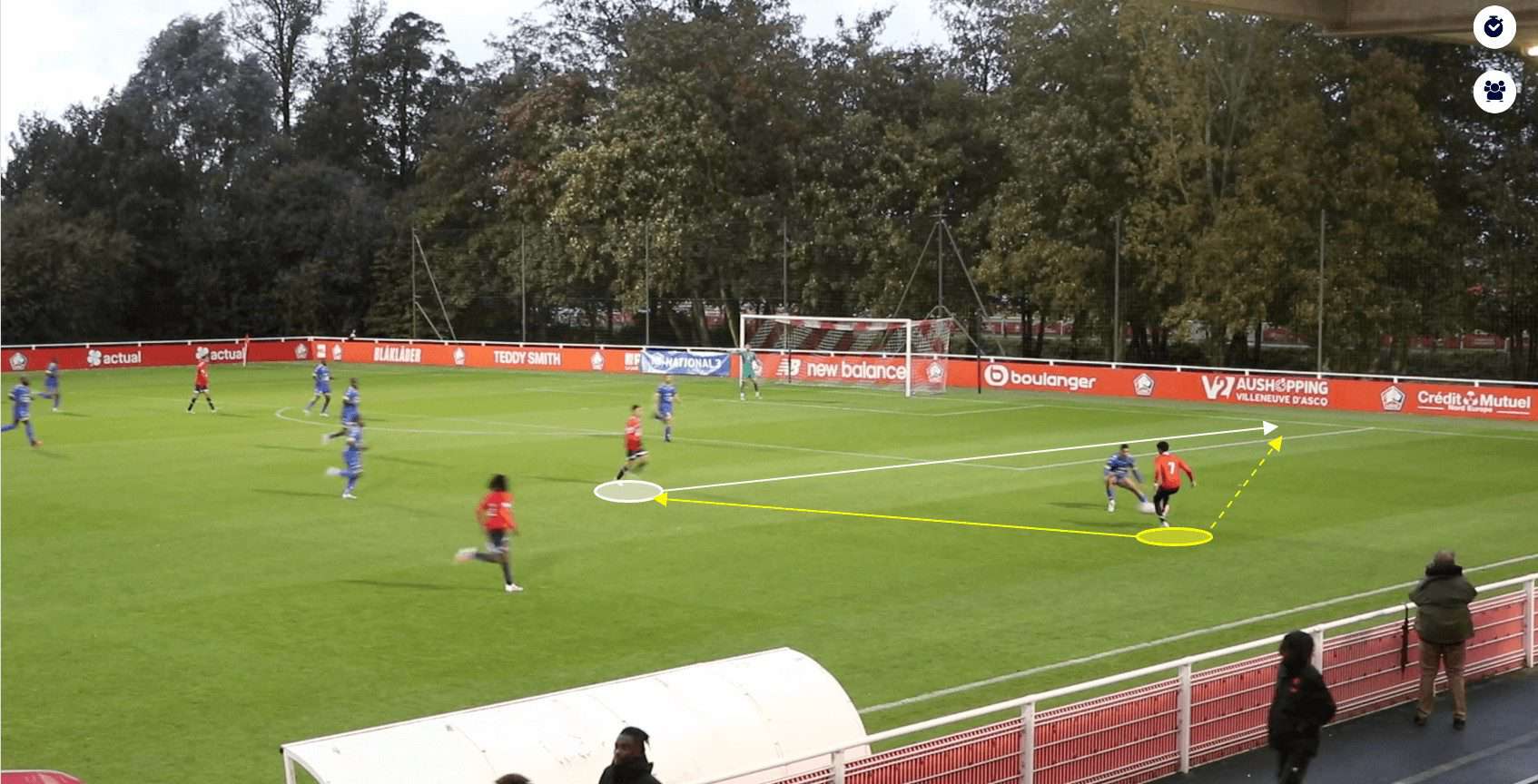
Furthermore, Malouda links up well with his fellow attacking players. He frequently looks to play quick one-twos to bypass the opposition and advance further into the attacking third. Here, he links up with his teammate via a quick interchange of passes, allowing him to make a run to the byline with the freedom to put a cross into the box.
His ability to link up play is instrumental in creating these cohesive attacking movements. By establishing a strong connection with fellow teammates, particularly midfielders and/or overlapping full-backs, Aaron Malouda can orchestrate the intricate passing sequences that, so often, allow his team to successfully build attacks.
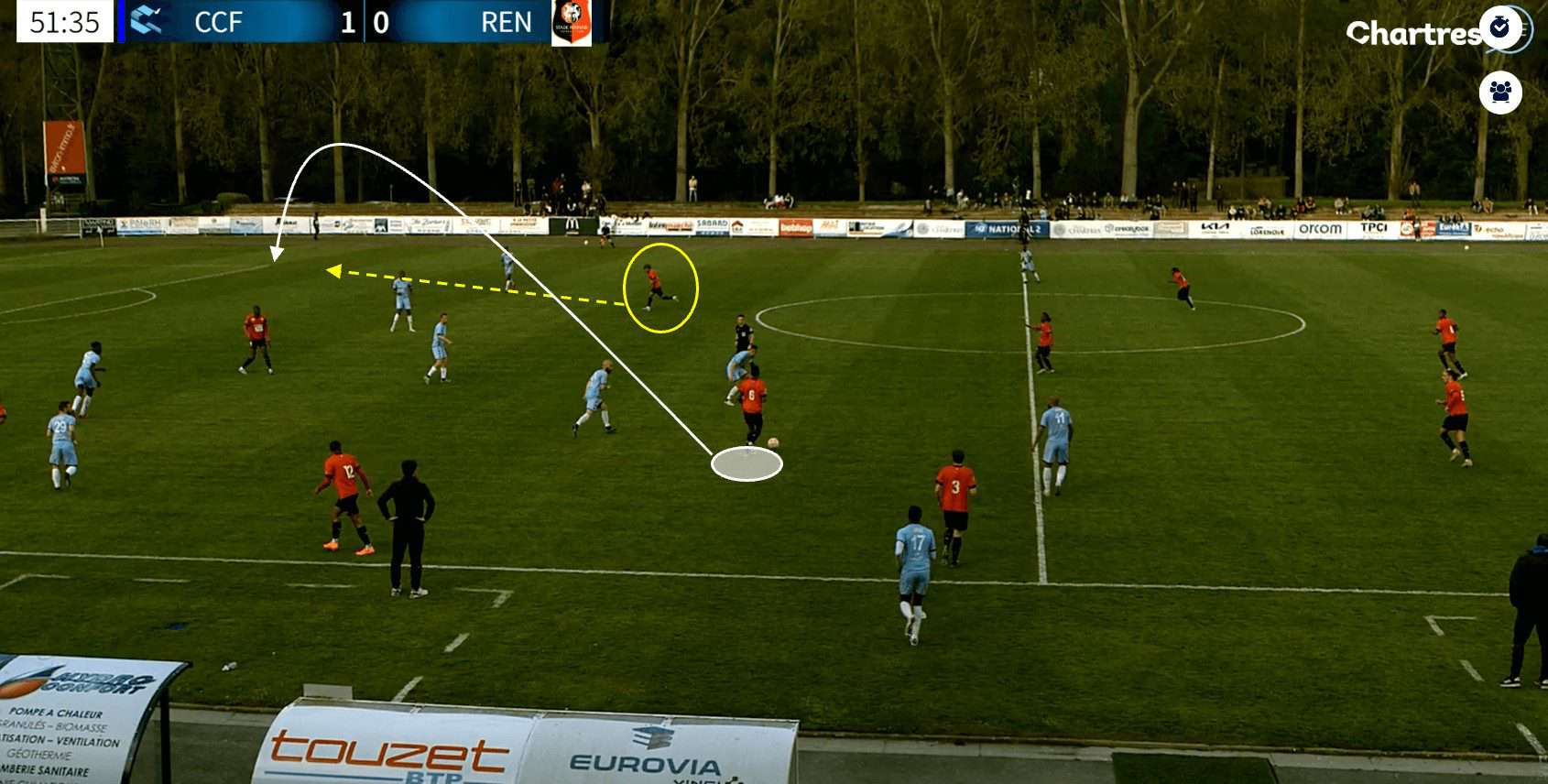
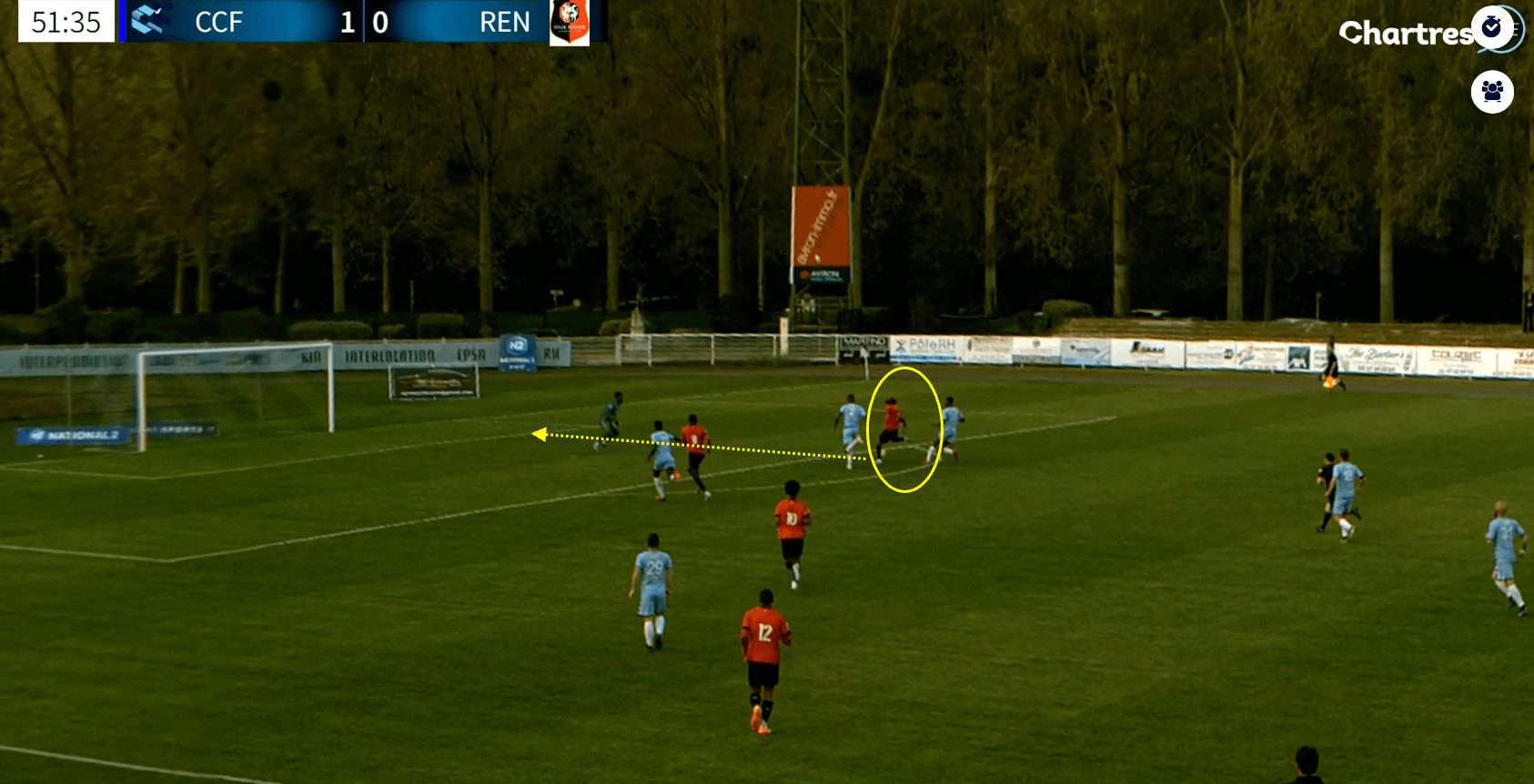
Moreover, Aaron Malouda showcases intelligent off-the-ball movement, enabling him to exploit spaces in the opponent’s defence. In the example above, he drifts in from the right wing and makes a run in behind the opposition’s defensive line. His teammate can find him via a wonderful lofted pass; consequently, Malouda is through 1v1 with the keeper.
By reading the game, anticipating defensive shifts, and making these well-timed runs, he can position himself in areas that are considered good goalscoring positions. This dynamic movement confounds defenders and forces them to make decisions under pressure, creating openings for Malouda and his teammates.
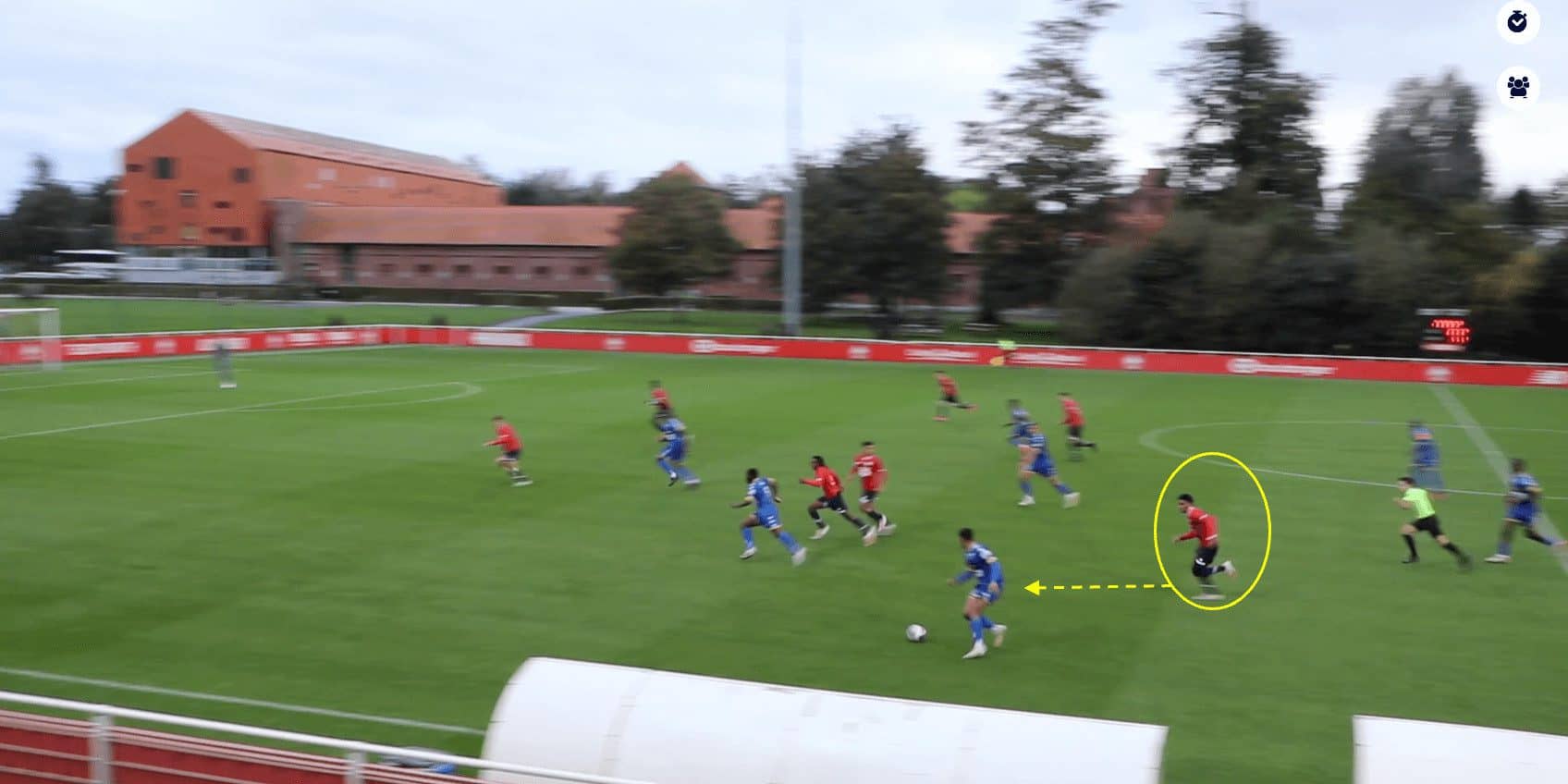
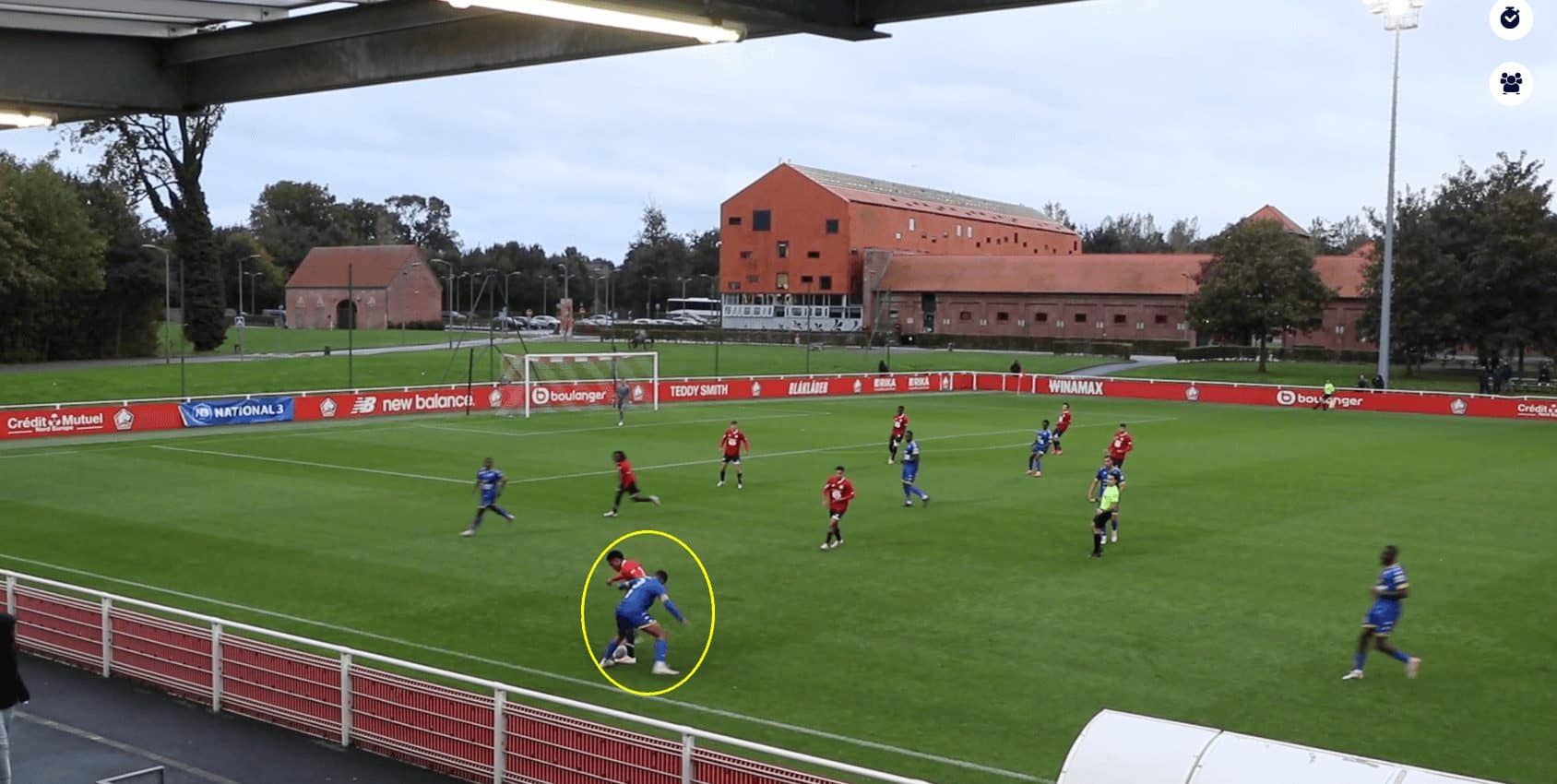
For all of Malouda’s skilful attacking play, he also works hard defensively. As we can see here, he uses his pace to track back effectively and puts in a good tackle on his opponent, resulting in him regaining possession for Lille. He can read the game well from a defensive perspective and knows how to position himself to close off passing lanes. He averages 1.7 ground duels per 90 and 2.4 tackles per 90 which shows he is willing to work hard in the defensive phase of play.
Malouda understands he needs to provide cover and support for the full-back in his defensive responsibilities. He has no problems tracking back to assist his defensive counterpart, preventing opposing attackers from exploiting the spaces left behind when the full-back ventures forward.
Gédéon Elonga Osango
The second player we are going to look at is 17-year-old Gédéon Elonga Osango. Although primarily a defensive midfielder, he has spent most of this season playing as a central defender for Lille U19s.
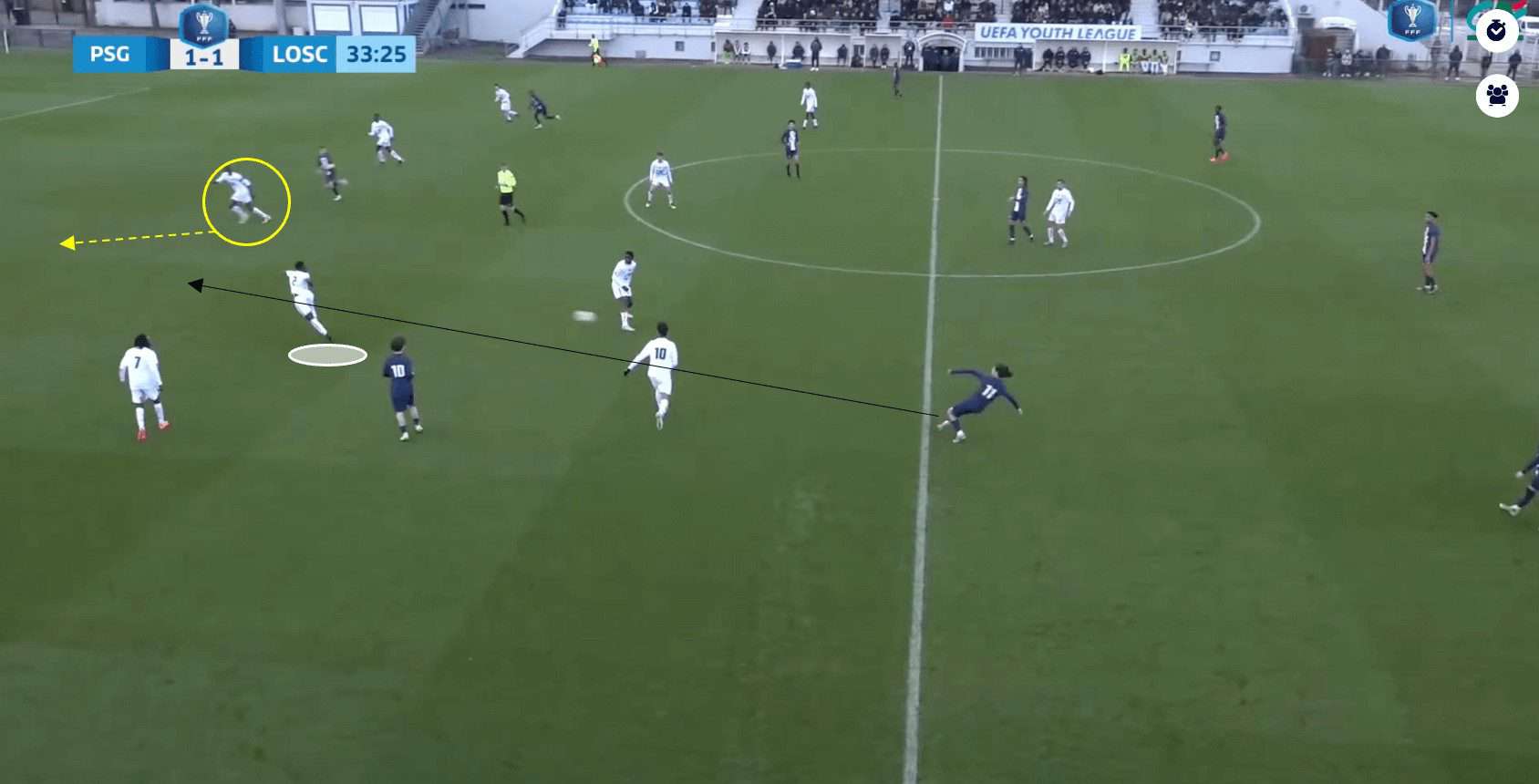
Elonga Osango possesses some good tactical intelligence, which he uses in defensive situations. In this instance, we can see that the full-back (highlighted by the white circle) is somewhat caught out of position. PSG are looking to exploit this by playing a pass into the vacated space, hoping their forward will be able to run onto it. The Lille centre-back reads the game well and makes an excellent covering run to intercept the pass and stop the PSG attack.
As a defender, covering for an out-of-position teammate is crucial in preventing opposition attackers from exploiting the vacated space. On this occasion, Elonga Osango’s well-timed movement and positioning successfully thwart the attacking players attempting to exploit the space left by the advanced full-back. This proactive covering not only mitigates defensive vulnerabilities but also disrupts the opponent’s attempt to capitalise on the situation.
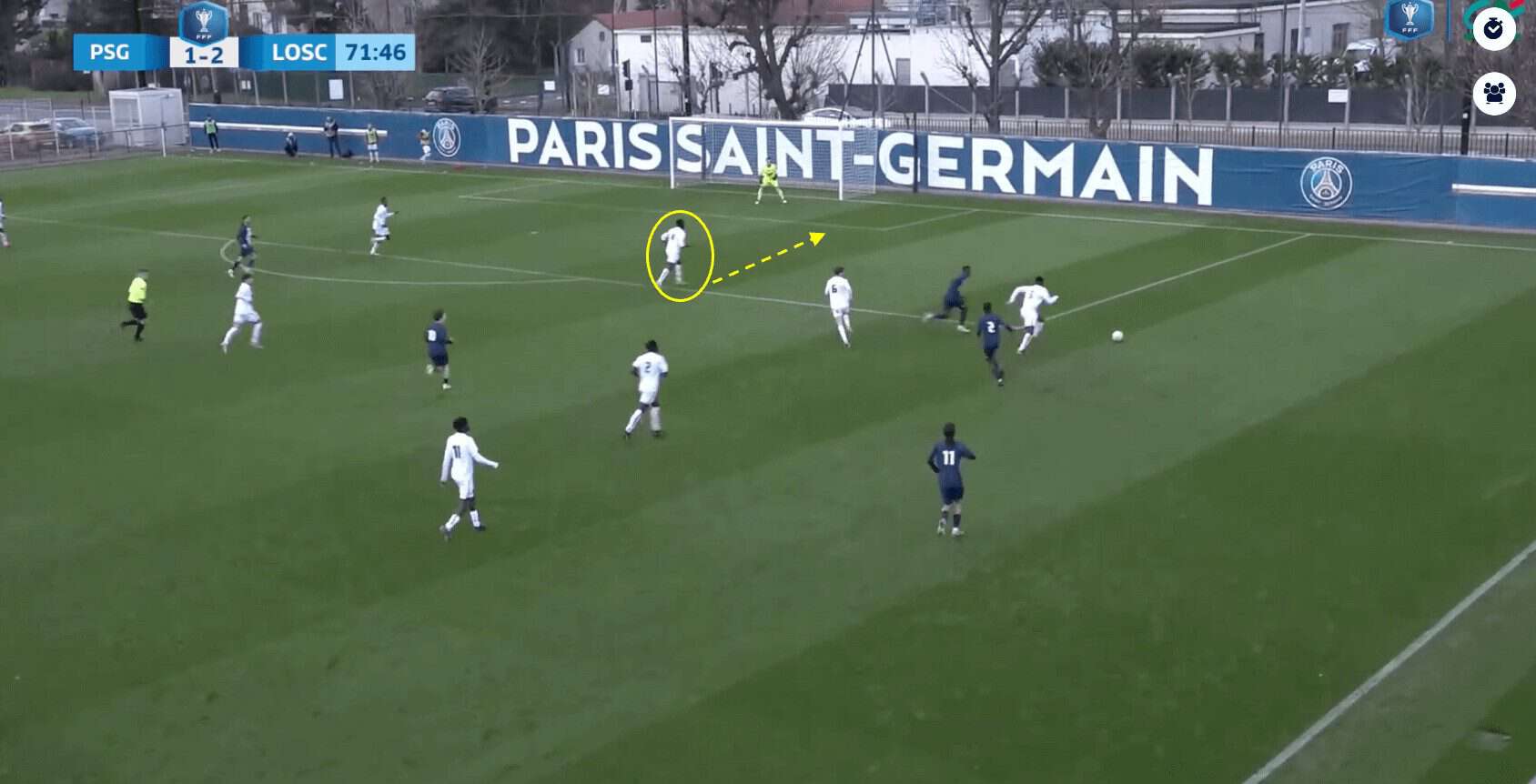
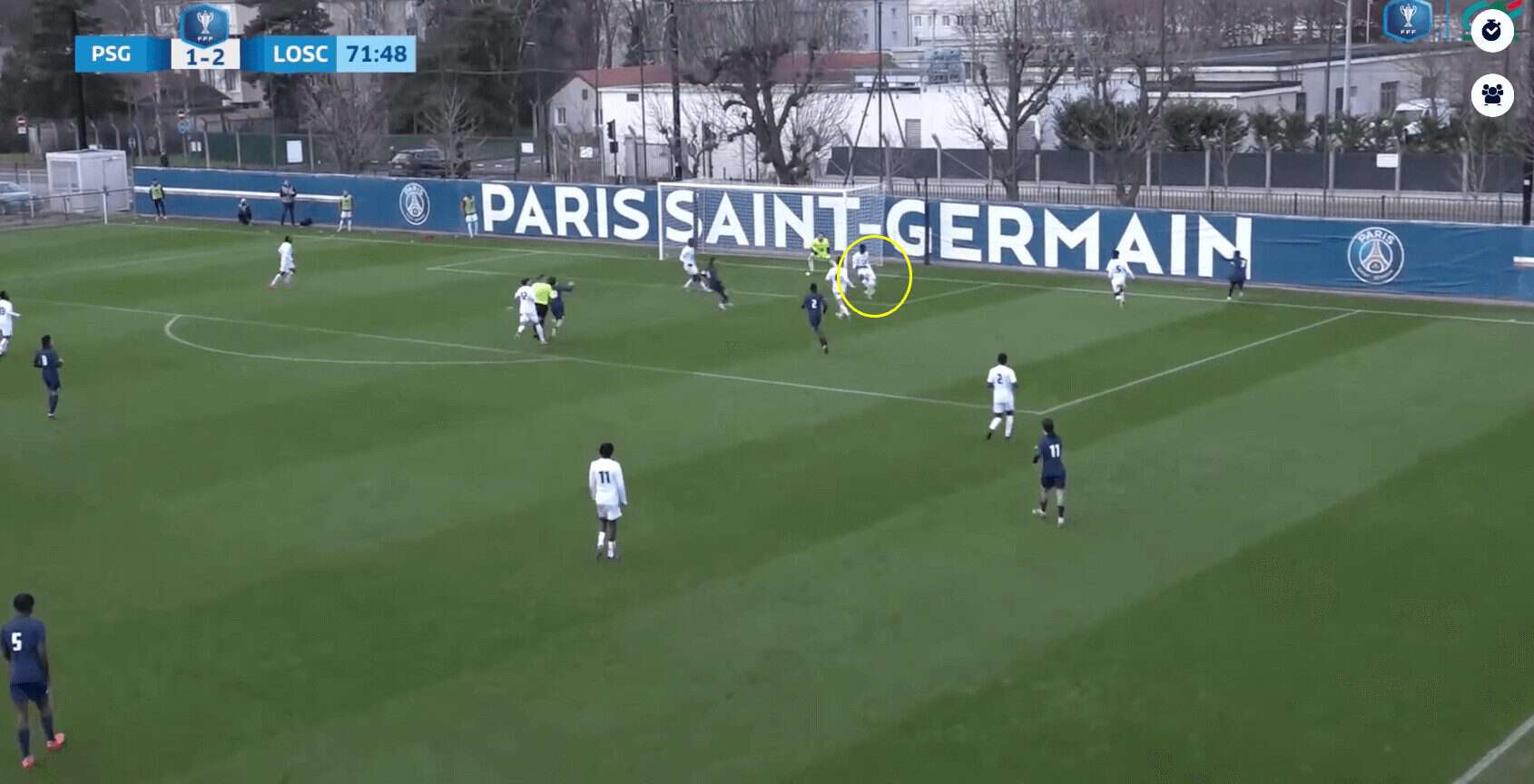
Additionally, Elonga Osango is very adept as a central defender when dealing with crosses. He gets into good positions to make interceptions and clearances while knowing where his opponent is. Here, anticipating that the attacker will reach the ball ahead of the full-back, Elonga Osango tracks back and intercepts the cross successfully.
Furthermore, the young Lille defender can anticipate the path of the ball and position himself accordingly. This involves assessing the delivery of the cross, the movement of attacking players, and potential areas of vulnerability in the defensive setup. This, of course, means he can proactively position himself to intercept or clear the incoming cross, preventing the opponent from carving out a goalscoring opportunity.
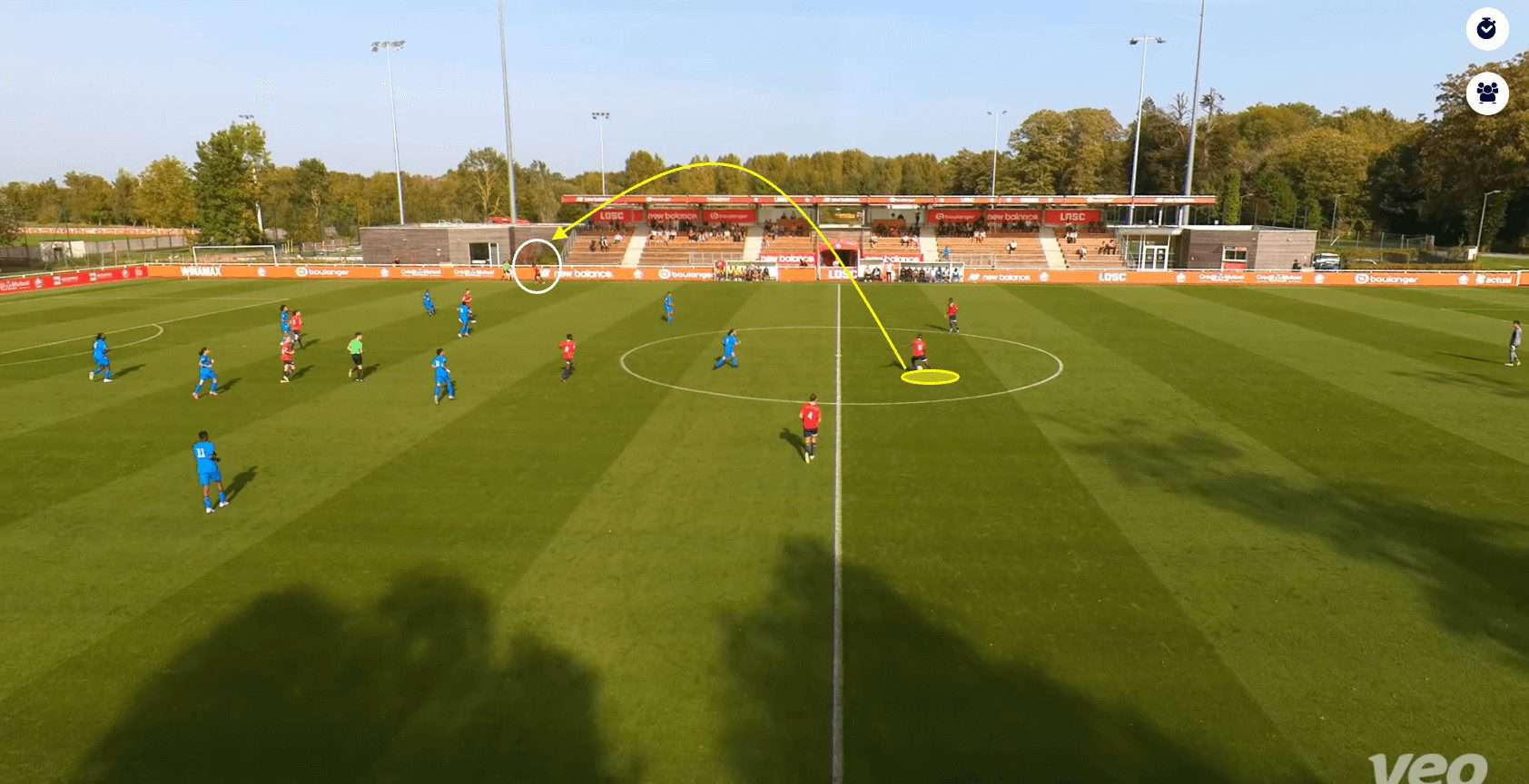
As a result of the years spent playing as a defensive midfielder, Elonga Osango has an extensive passing range to call upon. Primarily, Lille U19s will look to use short passes and build up from the back. However, he will use his long passing to kick-start attacks and as a way of bypassing the crowded midfield areas. We can see in this instance he plays a long pass out to the right flank in an attempt to quickly transition into attack.
The young defender averages 92% pass accuracy per 90, which shows how reliable he is on the ball, and this number is impressive considering it includes long passes as well. Moreover, he looks to play positively, averaging 27 accurate forward passes per 90, and 0.26 key passes per 90.
Elonga Osango often becomes a vital link between the defensive and midfield units. In Lille U19’s possession-based style of play, the defender acts as an initiator of build-up play, distributing the ball to the midfielders or wide players. Elonga Osango’s capacity to play very accurate short passes in tight spaces is crucial for transitioning the ball smoothly from the defensive to the midfield zone. Plus, his ability to play accurate long passes offers some useful versatility to Lille when they are looking to transition quickly into attack.
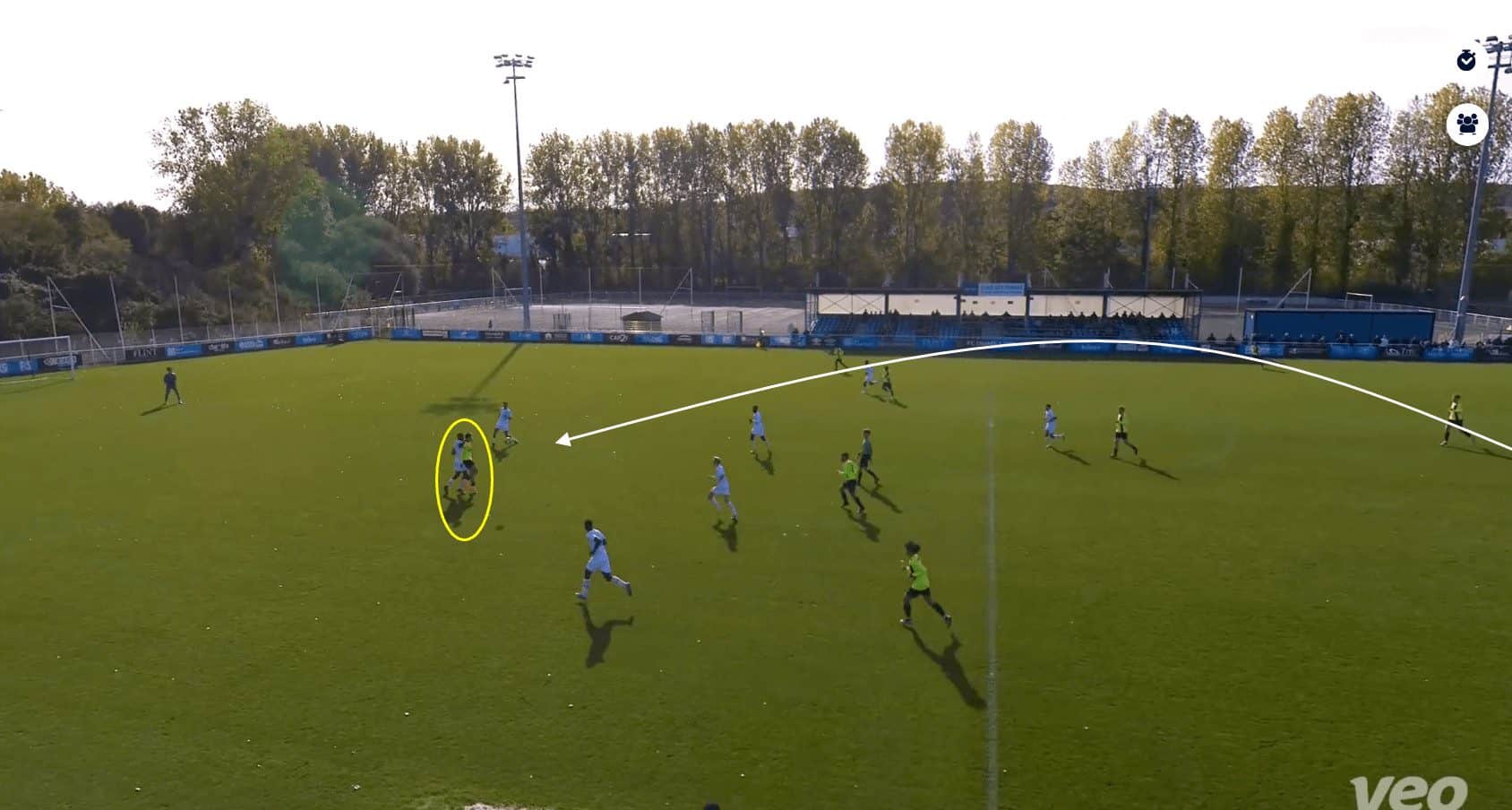
Elonga Osango is a proactive defender who likes to mark his opponent tightly. While there is the obvious risk of the opposition player spinning him, the young Lille man does well in these situations. He follows his opponent and prevents him from being able to turn with the ball, often forcing him backwards or into making an error. In this scenario above, he uses his strength to put the opponent under severe pressure as he tries to control the ball. This results in a turnover and allows Lille to counterattack.
As a consequence of Elonga Osango staying close, he denies the opponent the luxury of a moment’s hesitation, forcing a quick decision-making process. The increased pressure is what forces errors, hurried passes, or turnovers, providing Lille with plenty of opportunities to regain possession and launch counterattacks.
Moreover, he is a robust physical presence who is not afraid to enter into duels with opponents. Elonga Osango averages 1.92 and wins 1.22 ground duels per 90. This shows he is a reliable defender in terms of his physical capabilities. Additionally, he averages 3.7 aerial duels per 90 and is successful in 2.9 per 90.
Adame Faïz
The final player we are going to look at in this scout report is 18-year-old central midfielder Adame Faïz. He is left-footed, can play as a central midfielder, or attacking midfielder, and is proficient out on the right.
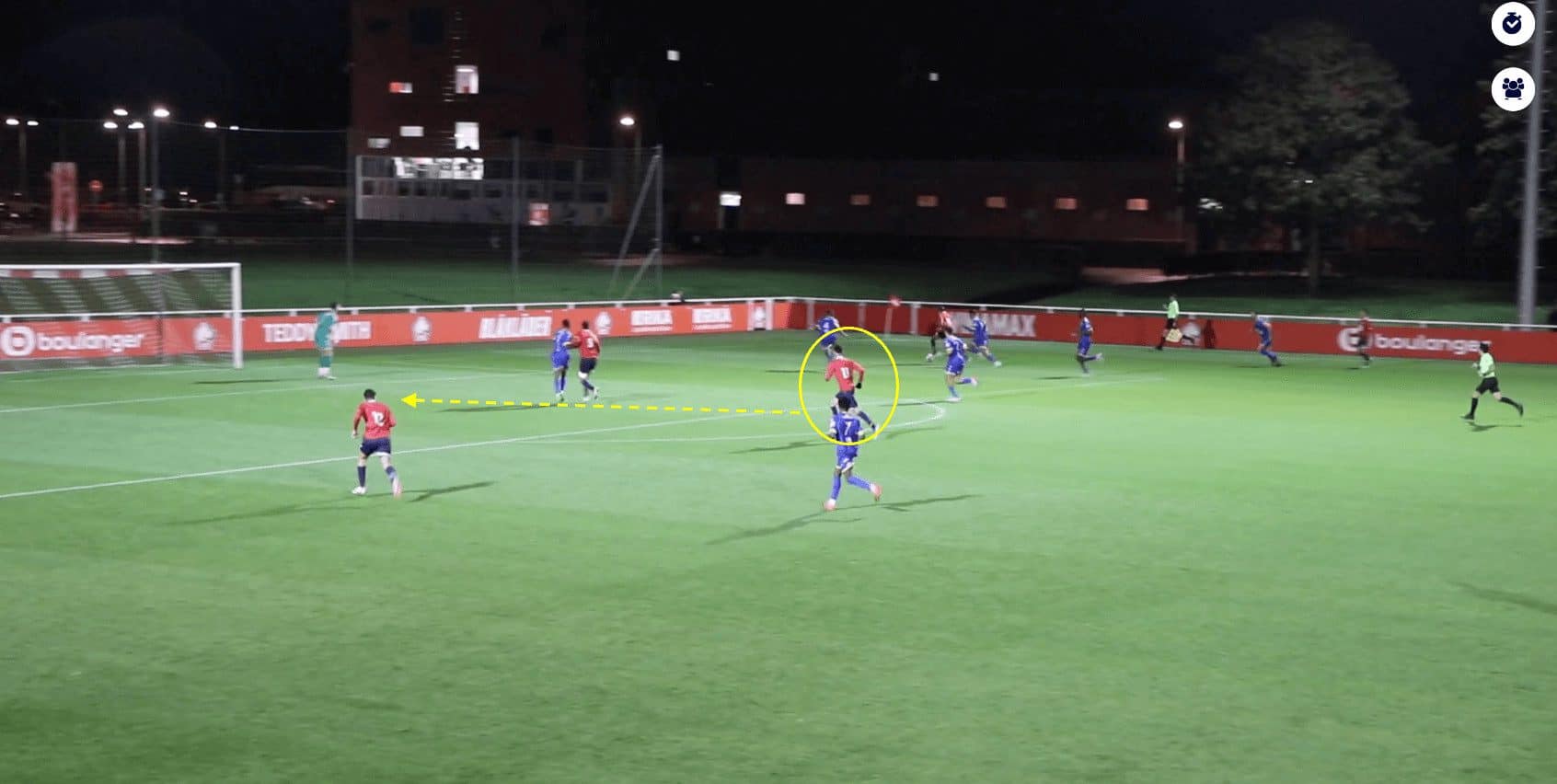
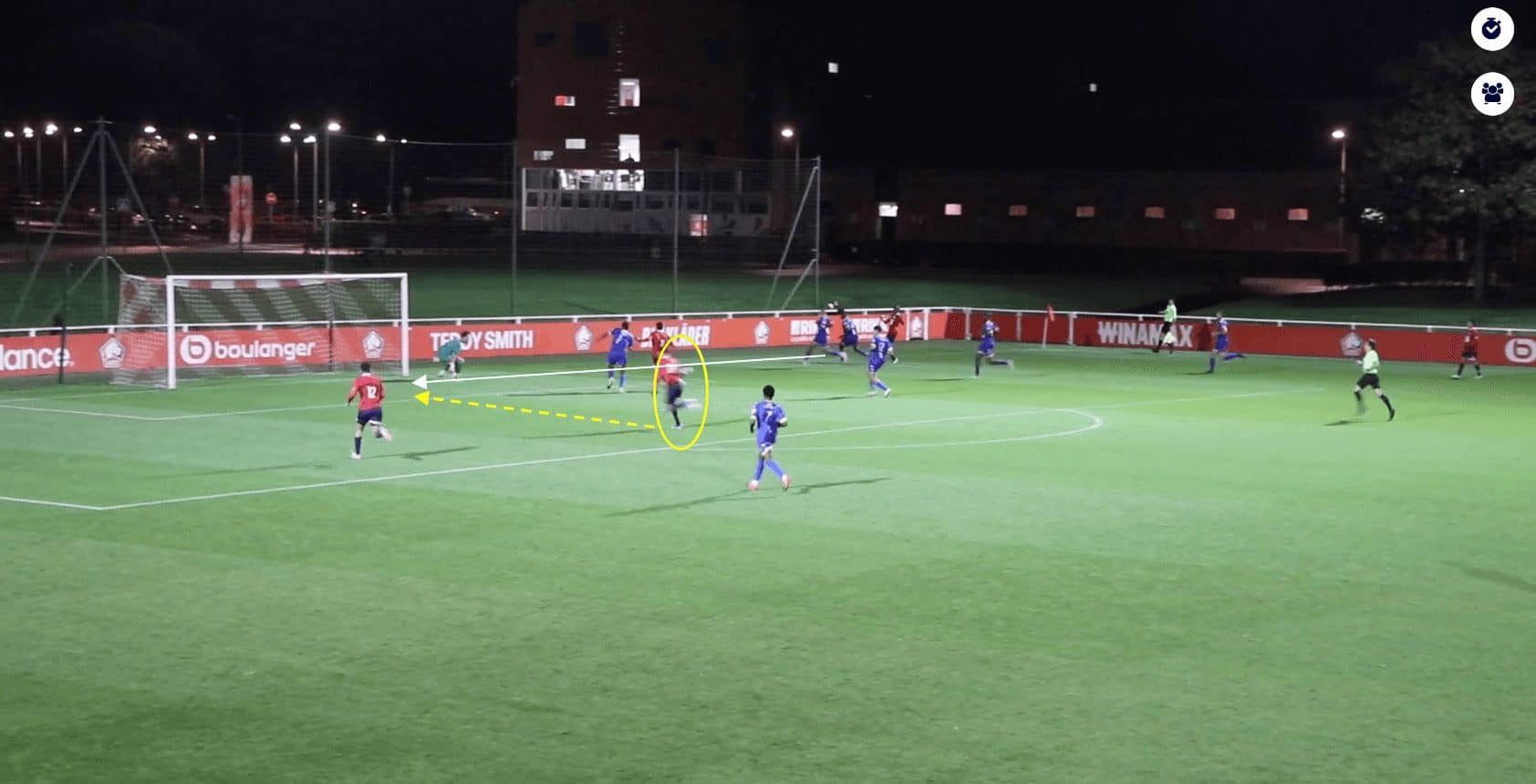
Faïz is a very dynamic midfielder who looks to venture forward whenever he can. We can see in this example that Lille are on the counterattack, and Faīz uses his excellent acceleration to make a run into the penalty area and turn in a low cross from the wide right.
These well-timed forward runs allow Faïz to contribute to goalscoring opportunities. He is an important goalscoring threat, whether making late runs into the box or positioning himself at the edge of the penalty area. His arrival in advanced positions creates uncertainties for opposing defenders, who must decide whether to track the midfielder’s run or prioritise other attacking players.
Furthermore, this supports the team’s transition from defence to attack. When possession is regained, Faīz can quickly advance into the attacking third, facilitating a faster and more dynamic transition. This quick progression catches opponents off guard and allows Lille to exploit spaces before the opposition can organise defensively.
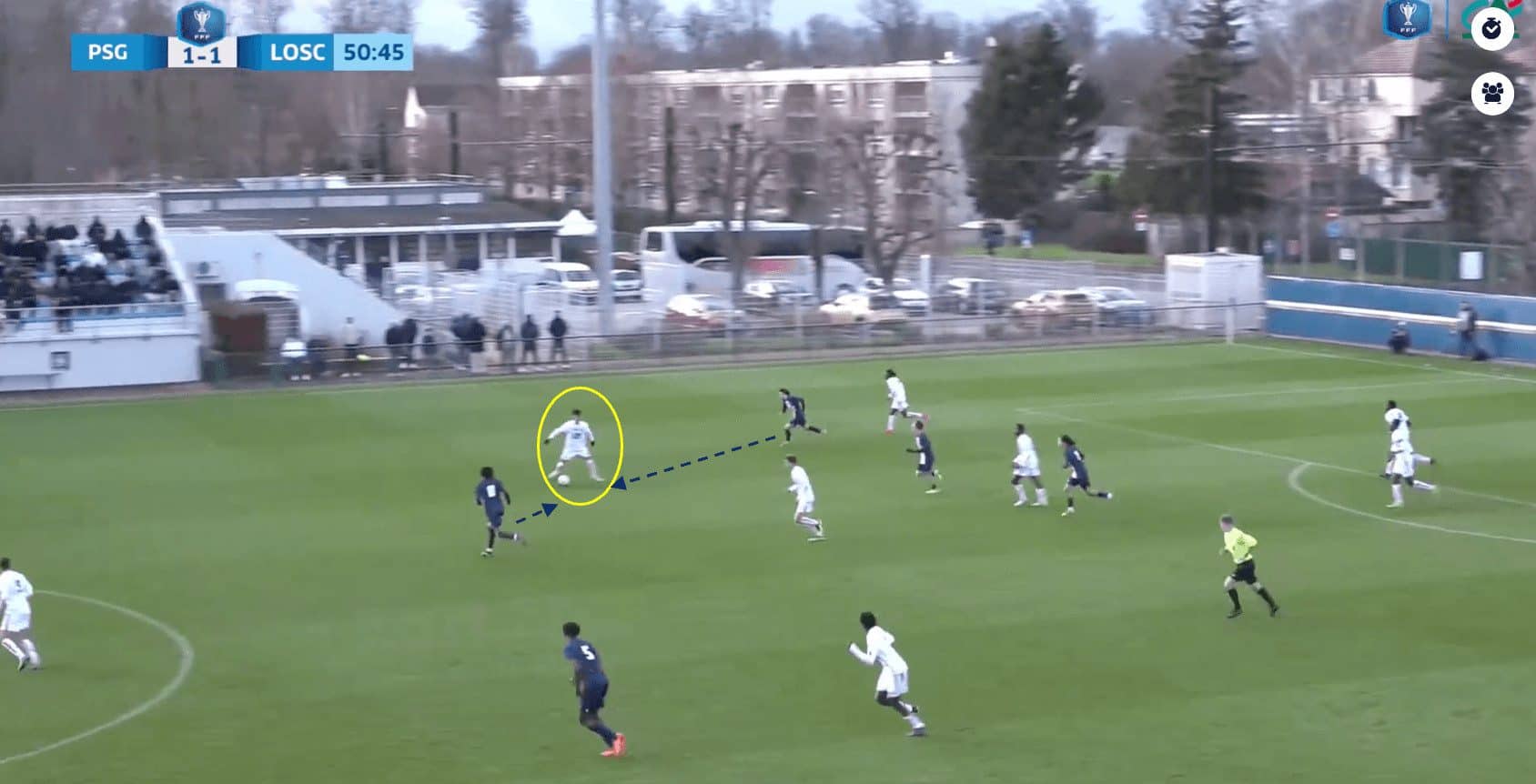
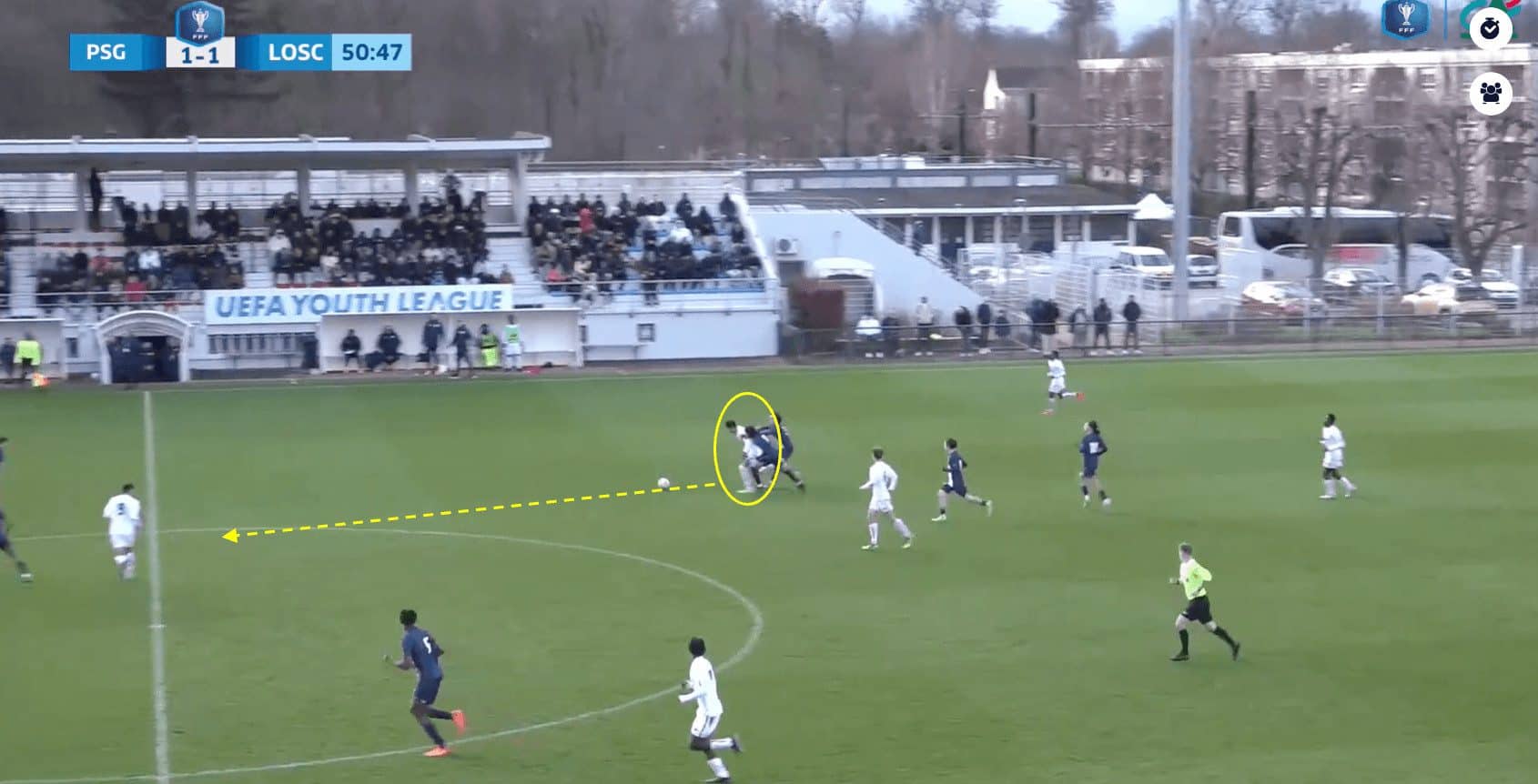
Moreover, Faīz’s ability to carry the ball forward is incredibly useful for Lille. He possesses excellent close control, allowing him to manoeuvre in the tightest spaces. In this instance, he receives the ball with two PSG players looking to close him down. As we can see, Faīz uses his speed and power to drive forward in possession. His physical strength and close control allow him to retain possession despite the opposition’s pressure.
Faīz has an instinct to progress the play whenever possible; this plays into his determination to retain possession and outmuscle his opponent(s). He averages 2.3 take-ons per 90 and thrives with quick feet and skilful ball manipulation to bypass opponents in the central areas.
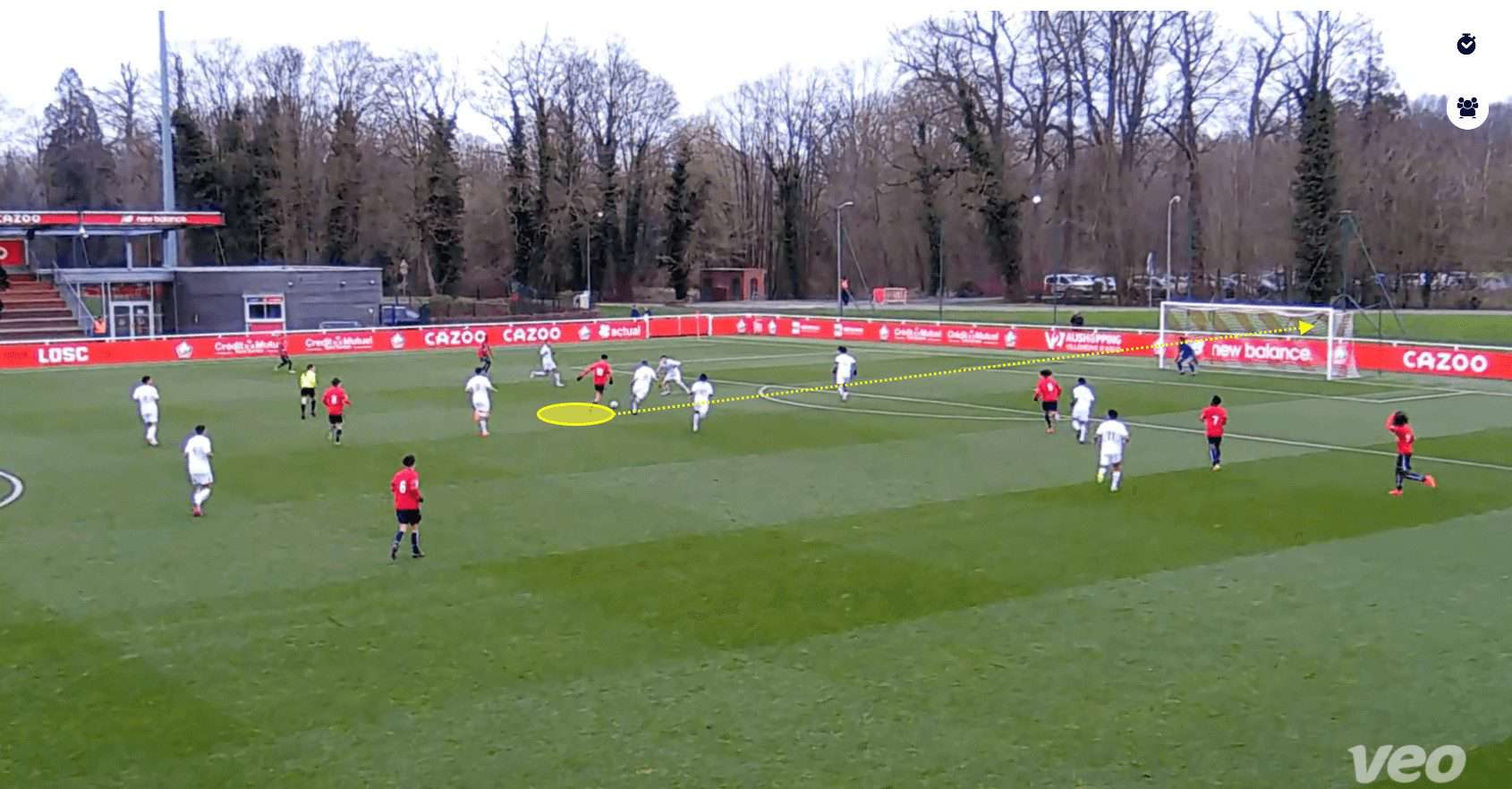
Adame Faïz’s ability to carry the ball into space also facilitates his wonderful shooting ability. He loves to get shots on goal from any distance, if we are being completely honest. Here, he drives forward with the ball and unleashes a powerful shot from outside the area. Faïz likes to hit shots early, often looking to catch the goalkeeper off guard and increasing his likelihood of hitting the back of the net.
The numbers indicate that the young midfielder takes 2.6 shots per 90. He averages 1.14 shots from inside the penalty area per 90 and 1.48 from outside the area per 90. Faïz’s proficiency in taking long shots certainly adds an element of surprise to Lille’s attacking strategy. Defenders and goalkeepers are often focused on anticipating passes or close-range efforts, meaning it can be unexpected for them to react swiftly to a sudden long-range shot.
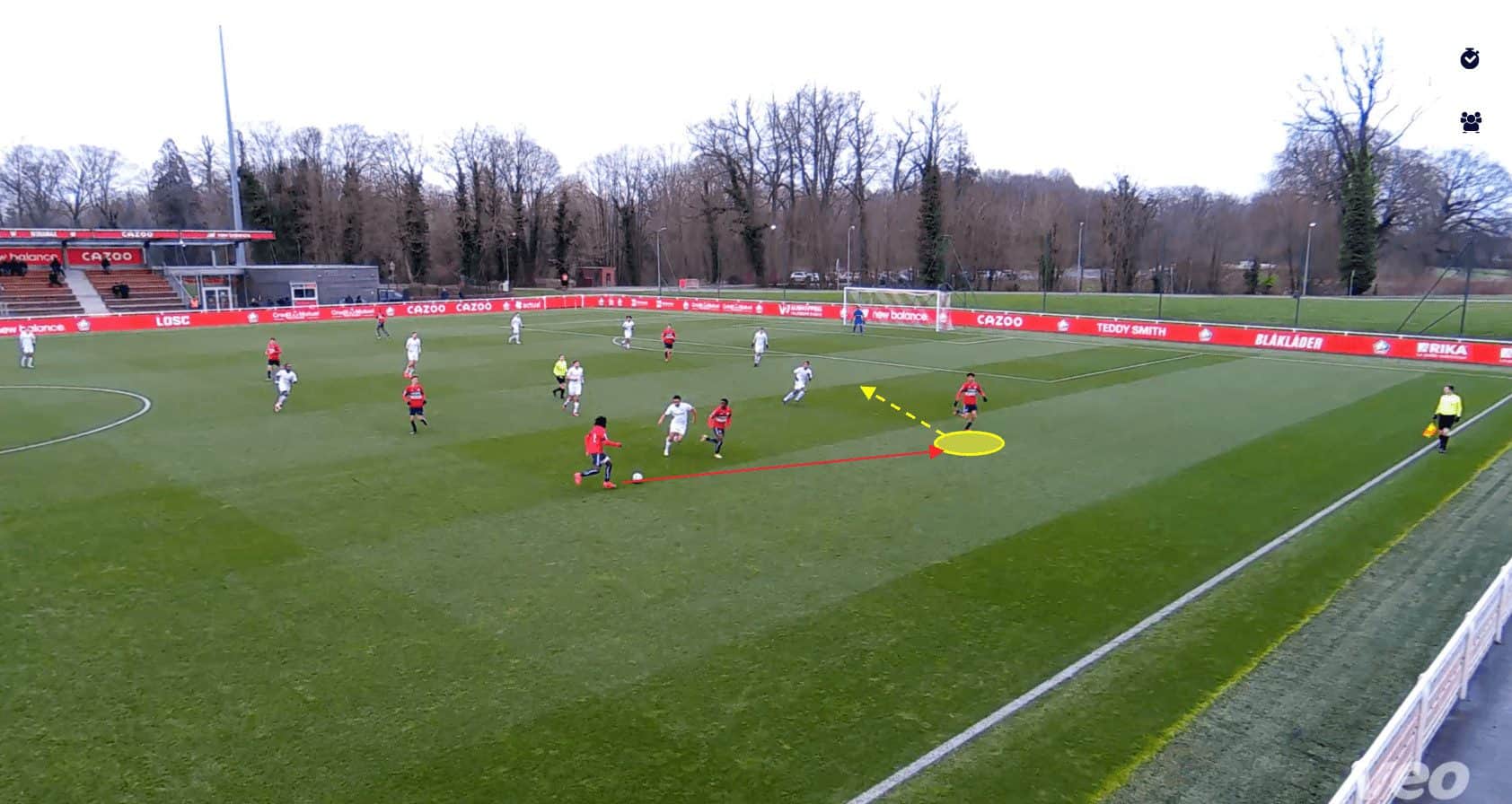

Of course, as a central midfielder, Faïz is expected to link up play and act as a conduit between defence and attack. Whilst this is not the strongest part of his game, he carries out these duties to a proficient level and demonstrates some good reading of the game and intelligent movements off the ball.
He has a great ability to move into pockets of space to receive the ball and works tirelessly throughout the game, constantly offering himself as a passing outlet for defenders. On this occasion, he drifts out to the right half-space to receive the ball and quickly plays it into the feet of the forward, who can control the ball, turn and execute a shot.
Faïz’s role in linking up play is particularly crucial in breaking down stubborn defensive structures. When faced with compact and organised defences, connecting passes and navigating tight spaces becomes paramount. Having a midfielder who excels in linking up play means Lille can unlock defences by threading precise passes, exploiting gaps, and creating opportunities for attackers to receive the ball in dangerous positions.
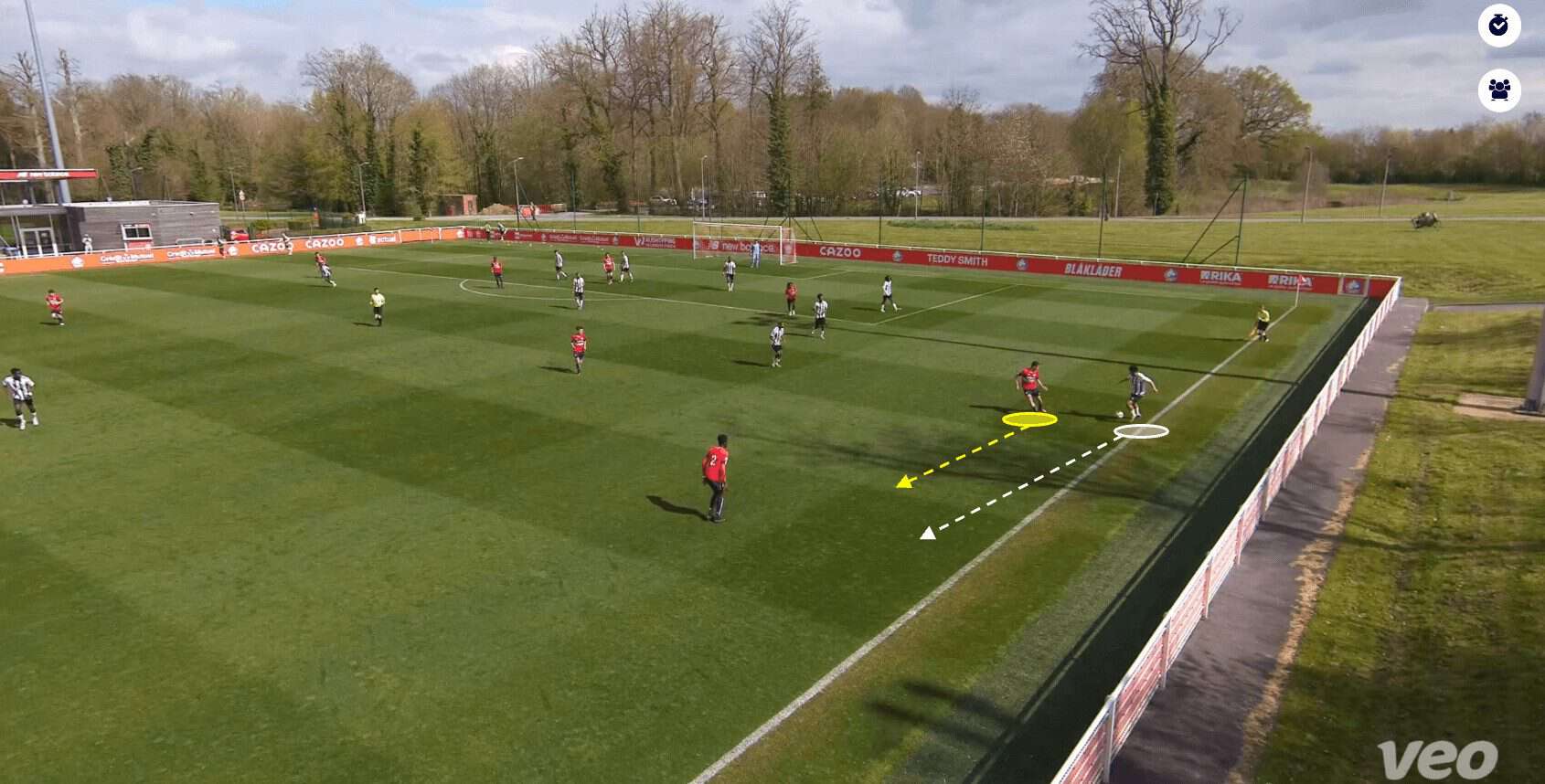
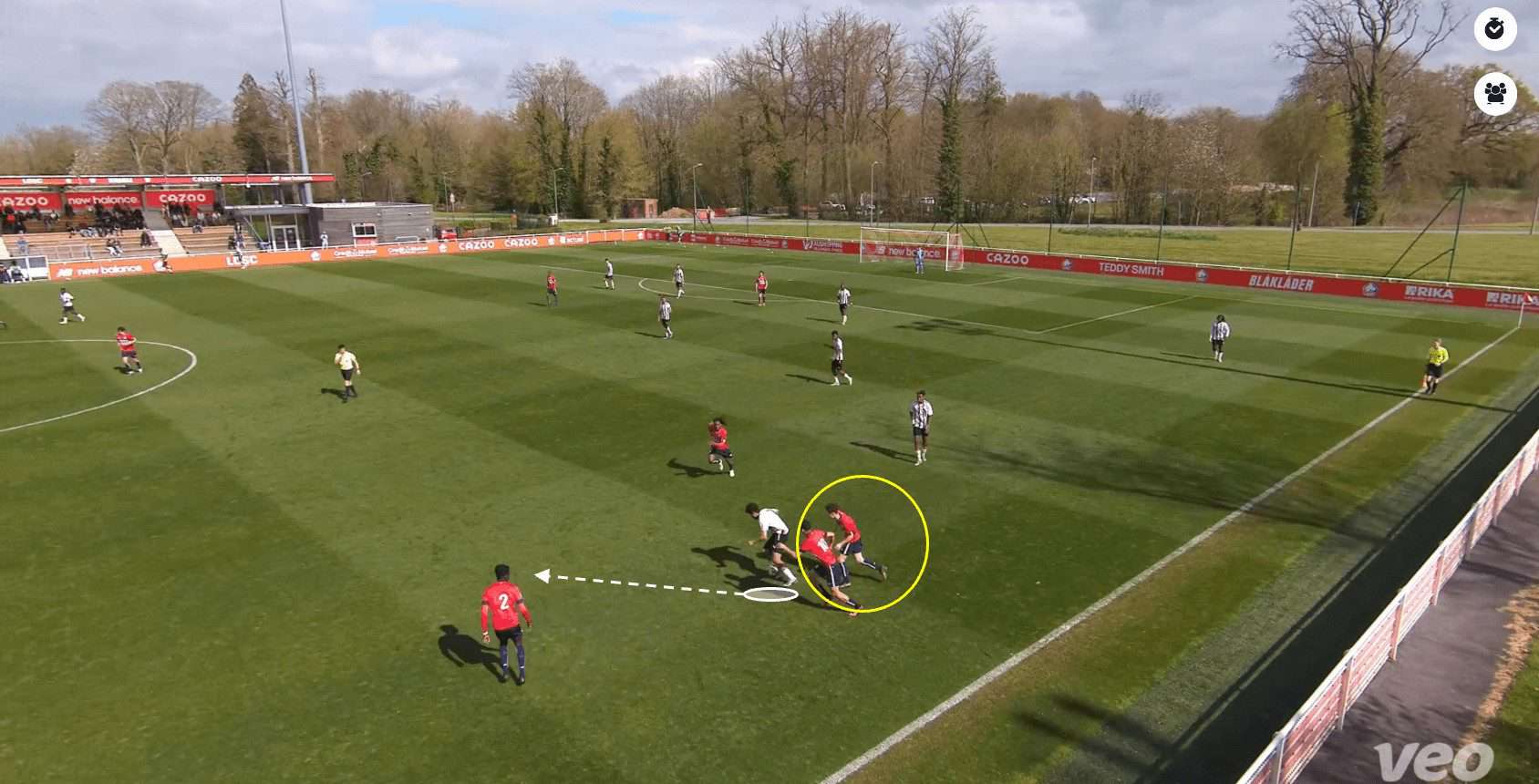
However, if there is one area of his game that could do with some improvement, it is defensively. Faïz rarely enters into defensive duels; when he does, he often comes off as second best. Averaging 0.45 ground duels and 0.34 aerials duels per 90; the young midfielder can often be something of a bystander in the defensive phase of play.
In this example, Lille have conceded possession, and the opposition is looking to build an attack. Faïz moves out to close down the opponent but doesn’t get tight enough to force a turnover. Instead of forcing the opponent down the line, he allows him to cut inside, where he is more likely to be able to play a progressive pass.
Conclusion
This scout report has highlighted three players to watch in the Lille youth system. Aaron Malouda is ready to follow in his father’s footsteps and break into the first team with his dynamic on-the-ball abilities. Gédéon Elonga Osango is a little rougher around the edges but possesses all the qualities that are expected of a modern ball-playing defender. Additionally, Adame Faïz is a talented midfielder who provides many attacking threats.
With Lille consistently giving opportunities to young players such as Leny Yoro, it won’t be long before we see these three names on the team sheet.





Comments